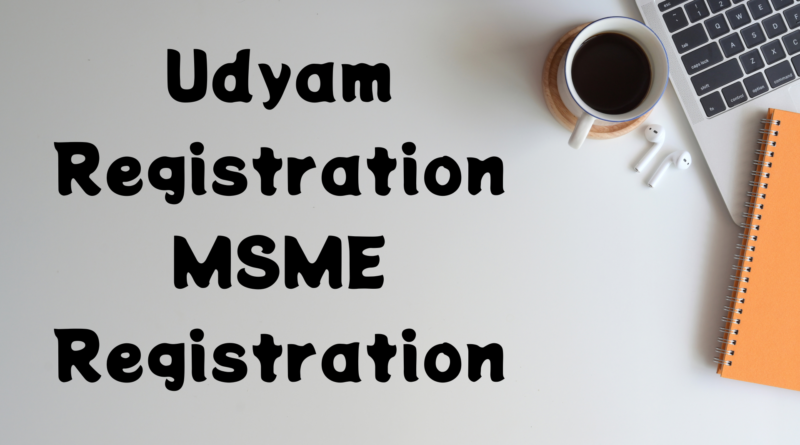Udyam Registration MSME Registration
Introduction
The Government of India has continually worked towards supporting Micro, Small, and Medium Enterprises (MSMEs) by simplifying registration processes and offering various benefits. The transition from the old MSME Registration (also known as Udyog Aadhaar) to the new Udyam Registration Online is a significant step in this direction. This guide outlines the key differences between Udyam Registration and the old MSME Registration system, as well as important updates.
Overview of MSME Registration (Udyog Aadhaar)
Before the introduction of Udyam Registration, businesses registered under the MSME Development Act, 2006, using the Udyog Aadhaar system. This process provided a unique identification number to MSMEs, enabling them to avail of various benefits.
Overview of Udyam Registration
Launched on July 1, 2020, Udyam Registration is a more streamlined and efficient process introduced by the Ministry of Micro, Small, and Medium Enterprises. It aims to simplify the registration process and ensure better tracking and management of MSMEs in India.
Key Differences Between Udyam Registration and MSME Registration
1. Registration Process
Udyog Aadhaar (Old MSME Registration):
- Aadhaar Requirement: The Aadhaar number of the business owner was required.
- Process: The process involved filling out the Udyog Aadhaar Memorandum (UAM) form online, where business owners provided their personal and business details.
- Validation: Self-declaration and minimal validation.
Udyam Registration:
- Aadhaar and PAN Requirement: Both Aadhaar and PAN numbers are mandatory for registration.
- Process: The registration process is fully online and integrated with the Income Tax and GST systems for real-time data validation.
- Validation: Automatic validation of PAN and GSTIN details, reducing errors and ensuring accuracy.
2. Classification Criteria
Udyog Aadhaar (Old MSME Registration):
- Investment-Based Classification: MSMEs were classified based on investment in plant and machinery or equipment only.
- Categories: Different investment limits for manufacturing and service sectors.
Udyam Registration:
- Composite Criteria: Classification is based on both investment in plant and machinery or equipment and annual turnover.
- Unified Classification: No distinction between manufacturing and service sectors; the same criteria apply to both.
- Updated Limits:
- Micro Enterprises: Investment up to INR 1 crore and turnover up to INR 5 crores.
- Small Enterprises: Investment up to INR 10 crores and turnover up to INR 50 crores.
- Medium Enterprises: Investment up to INR 50 crores and turnover up to INR 250 crores.
3. Documentation and Compliance
Udyog Aadhaar (Old MSME Registration):
- Documents: Basic details like Aadhaar, business information, and bank details.
- Compliance: Limited to initial registration and occasional updates.
Udyam Registration:
- Documents: Aadhaar and PAN numbers are mandatory. GSTIN is required for businesses exceeding the GST threshold limit.
- Compliance: Annual updation of business details and financial information to maintain the accuracy of the registration data.
4. Integration with Other Government Systems
Udyog Aadhaar (Old MSME Registration):
- Integration: Limited integration with other government databases, leading to discrepancies and outdated information.
Udyam Registration:
- Integration: Seamless integration with the Income Tax and GST databases for real-time validation and updates.
- Single Window System: Simplified process with fewer chances of errors and discrepancies.
5. Validity and Transition
Udyog Aadhaar (Old MSME Registration):
- Validity: Udyog Aadhaar numbers were issued without a specified validity period.
- Transition: Businesses registered under Udyog Aadhaar were encouraged to transition to the Udyam Registration system by March 31, 2021.
Udyam Registration:
- Validity: Udyam Registration is valid as long as the enterprise continues to meet the specified criteria. Businesses must update their information annually.
- Mandatory: New and existing businesses must register or transition to Udyam to avail of government benefits.
Benefits of Transitioning to Udyam Registration
- Enhanced Credibility: Real-time data validation ensures accurate and up-to-date information, enhancing the credibility of registered businesses.
- Access to Government Schemes: Registered MSMEs can access various government schemes, subsidies, and financial assistance programs more efficiently.
- Easier Compliance: Simplified and integrated processes reduce the compliance burden on businesses.
- Priority Sector Lending: Improved access to credit and preferential treatment from banks and financial institutions.
- Protection and Legal Support: Better protection against delayed payments and legal support under the MSME Development Act, 2006.
Conclusion
The transition from MSME Registration (Udyog Aadhaar) to Udyam Registration marks a significant improvement in the way MSMEs are registered and managed in India. The new system offers a more streamlined, accurate, and integrated process, providing businesses with enhanced benefits and support. By understanding the key differences and updates, businesses can ensure they meet the eligibility criteria and take full advantage of the opportunities provided by Udyam Registration.

